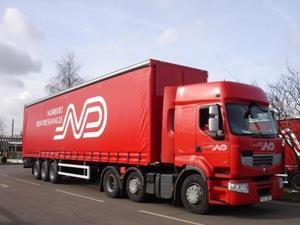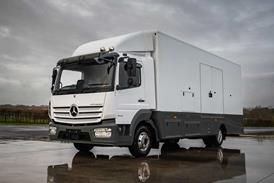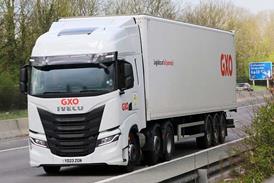
A new report claims UK operators could make significant savings if they were allowed to add overlength vehicles to their fleets.
A new study published last week suggested that allowing the use of ‘super’ semi-trailers could save the haulage industry £226m a year in reduced running costs.
Such findings appear to strengthen the economic argument for the use of longer vehicles, but the study also puts forward a case for 'super semis' on safety and environmental grounds.
The report, Impact Assessment: High-Capacity Vehicles, was sponsored by Kimberly-Clark, and the healthcare products’ manufacturer has put together figures on the potential savings of running super semi-trailers.
Transport costs
Kimberly-Clark has calculated that transport costs account for 10% of the shelf price (£2.80) per pack of four toilet rolls.
However, by allowing these goods to be moved for part of their journey on 25.25m-long high-capacity vehicles (HCVs) transport costs for 75% of its products would be reduced by 20%. This saving – the equivalent of 5.5p per pack of toilet rolls – could be passed to the consumer, which is important in a very competitive market, said Peter Surtees, European logistics director at Kimberley-Clark.
Produced by the Business, Operations, Supply Chain and Transport Research Group at the University of Huddersfield, the report assesses the environmental, economic, safety and practical impacts of increasing the maximum length of vehicles while maintaining the maximum gross weights at 44 tonnes.
By using HCVs, lightweight goods such as packaging, perishable and non-perishable foodstuffs, parcels, manufactured goods, manufactured articles and paper/paperboard products could be palletised or put in roll cages and transported in bigger but fewer loads.
Surtees illustrates this by explaining that if Kimberley-Clark were to use HCVs it could increase the number of pallets it moves in a single load from 26 to 40, a volume rise of 53%.
If this was replicated across the industry, HCVs could be used for 1.4 billion articulated vehicle kilometres travelled, or 15% of the overall UK total. This would not only reduce annual transport costs by £226m, but CO2 emissions by 96,000 tonnes and lorry kilometres by 4%.
Selective routes
Surtees admits to being "surprised" at how applicable the use of HCVs could be in the UK, but said they won’t work in all types of operating circumstances, not initially anyway.
Kimberley-Clark and its logistics partner Norbert Dentressangle are taking part in the 10-year Department for Transport (DfT) trial of 14.6m and 15.65m longer semi-trailers, launched in December 2011.
"We’re using them on selective routes such as north-south trunking. We’re not using them on customer deliveries yet or to big retailers. We’re using them on inter-company transport, where there’s consistent, high volumes - the same principles would apply for HCVs," said Surtees.
Improving efficiency

Peter Brown, MD of Norfolk-based Jack Richards & Son, said he supported any initiative that cut vehicle movements and improved efficiency. "We carry a lot of packaging and breakfast cereals and that [HCVs] would be very useful in that kind of application," he said.
However, Brown’s experience with the longer semi-trailer trial – he runs 30 of them - has left him sceptical about how widely useable HCVs could be.
"Longer semi-trailers are useful in a dedicated environment but are almost useless to the general haulier," he said.
"Kelloggs might carry 20 loads one day and 60 another day to all points of the country. If you only run a few longer semi-trailers I’m not sure I can guarantee I can put them back into position to run for them again and that they will be available," said Brown.
Surtees recognises that while neither scheme might work for mixed loads and general haulage at the moment, it lays down a gauntlet for operators to use vehicles more intelligently.
"When we moved from 12m to 13.6m trailers we had a gradual transition and gradual improvement in capacity," he said.
The University of Huddersfield report cites the experience of Holland, where HCVs have been in use for many years, as evidence that over time longer trailers can become successfully established.
Dutch treat
Recently, Lincoln-based Denby Transport became the first UK operator to run a 25.25m combination on a commercial operation, taking 40 pallets for Kimberly-Clark from Killingholme ferry terminal in Lincolnshire to Raamsdonksweer in Holland.
There are around 500 Dutch-registered HCVs allowed to use parts of the Dutch road network approved by authorities, with special permission needed for movements outside of that.
Such careful route planning can overcome concerns about HCV access issues, say the report authors.
Denby MD Peter Denby, said: "It is starting to gain momentum there. The Dutch infrastructure is largely no different to ours and there is a similar operating environment."
Another concern likely to be raised about the use of HCVs in the UK are the perceived detrimental impact they could have on the environment – through freight moving from rail to road - and road safety.
Practical alternative

Again, Dutch studies show that with improved training and technology aids (such as cameras) for drivers, HCVs are no more dangerous than other types of lorry.
On the issue of modal shift, Surtees said only 20% would be suitable for moving to road: "The payload on containers or rail would exceed HCVs in most cases – they would not be a practical alternative for us."
In fact, while the benefits to the consumer of cutting fuel consumption of transport operations are tangible, Surtees believes "it is the environmental argument I would push" when selling HCVs to the general public.
However, with the DfT having rebuffed the idea that longer combinations could be trialled under the longer semi-trailer pilot scheme, it appears the promised benefits of HCVs will remain untapped by UK operators - for now at least.
















